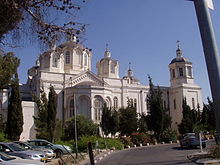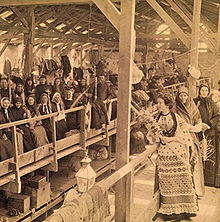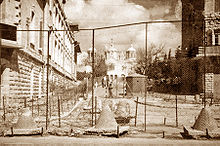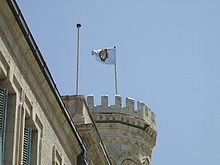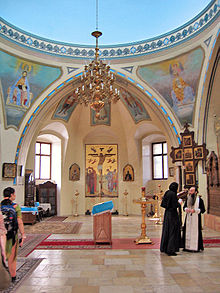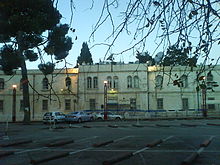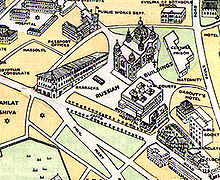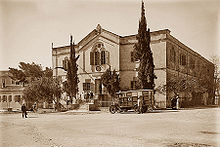- Russian Compound
-
The Russian Compound (Hebrew: מִגְרַשׁ הָרוּסִים, Migraš ha-Rusim, Arabic: المسكوبية, al-Muskubīya) is one of the oldest districts in central Jerusalem, including a large Russian Orthodox church and several former pilgrim hostels which are used as government buildings and for the Museum of Underground Prisoners. The compound covers 68 dunams (68,000 m²) between Jaffa Road, Shivtei Israel Street, and Street of the Prophets.
Contents
History
Formerly a Turkish cavalry parade ground during Ottoman rule, and originally known as “New Jerusalem” (Nuva Yerushama), the “Russian Compound” is a historical area abounding in heritage, scenery and unique environmental features.Throughout history, the hill on which the compound lies had been a prime location for mobilizing forces in order to make attempts to conquer Jerusalem (for instance, in 700 BC by the Assyrian garrison force, and in 70 AD by Roman troops mobilized by Titus).
The compound's construction from 1860-1864 was initiated by the Imperial Orthodox Palestine Society to serve the large amounts of Russian pilgrims to the holy city. Designed by Russian architect Martin Ivanovich Eppinger, it included a Mission, consulate, hospital, and hostels.[1] The compound became a centre of government administration for the British Mandate. The women's hostel served as the Mandate's central prison, and now serves as a museum for incarcerated members of the outlawed Zionist underground groups such as the Irgun and Lehi.[2]
The Israeli government purchased the Russian Compound in the 1960s, save the Holy Trinity church and another building. The complex was for many years a centre of Jerusalem's nightlife, though the municipality has recently closed the area nightclubs and is planning on redeveloping it as a residential area.[3] The municipality's headquarters at Safra Square (Kikar Safra) are themselves located on the edge of the compound, and several departments of the local government have their offices in the district as well.
Russian compound
Soon after their conversion to Christianity, the people of Russia began performing pilgrimages to the Holy Land, and by the 19th century the annual number of pilgrims reached into the thousands, flocking annually to the Holy Land, mainly on Easter. The Russian Orthodox Church sent more pilgrims to the Holy Land than any other denomination. Some even made the entire pilgrimage from Russia on foot.
The Russian Compound had begun to develop in the early 19th century with the opening of the first hospital for pilgrims outside of the Old City walls. It hosted a market where local peddlers could sell their wares and services to pilgrims. In 1847 the first Russian Ecclesiastical Mission was sent to Jerusalem, which, in 1857, was officially inaugurated with the recognition from the Sultan of Turkey. Its purpose was to offer Russian pilgrims spiritual supervision, provide assistance, and sponsor charitable and educational work among the Orthodox Arab population of Palestine and Syria.
In 1858, the entire Compound was sold to the Russian Empire. The Russian state and church during the reign of csar Alexander II who had become concerned about the Russian pilgrims in the Holy Land, subsequently built numerous hospices, monasteries and churches to handle the flood, including the monumental Russian Compound just north of the Old City, one of the most magnificent sites outside the walls. The location was chosen because of its proximity to the Old City and the Church of the Holy Sepulcher on the boundary between New Jerusalem and the Old City. It covers 68,000 m² between Jaffa Road, Shivtei Israel Street, and Street of the Prophets.
Between 1860-64 a hospice for women and the Russian consulate were built on the northeast side; to the southwest were a hospital, the residence of the Russian Orthodox religious mission with apartments for the archimandrite, the priests and well-to-do pilgrims, and a large hospice for men with altogether 2,000 beds. Sometimes tents had to be erected to accommodate the huge crowds of pilgrims. Finally the Holy Trinity Cathedral was built in 1872 as the center piece of the Compound.
The Imperial Orthodox Palestine Society, based in St. Petersburg, was the initiator and backer of the huge undertaking, and Russian architect Martin Ivanovich Eppinger was responsible for its design, influenced by Byzantine architecture. All the building materials, as well as the furniture, were brought from Russia by a Russian shipping line established especially for that purpose, which also brought shiploads of pilgrims. The large courtyards contained stables, chicken coops, wells and a laundry.
In 1890 the "Sergej Imperial Hospice" was completed by architect Frank Gia, an additional luxury accommodation for rich and honourable guests. It occupied 9 acres (36,000 m2) of land and was commissioned by Grand Duke Sergei (1857–1905), brother to Czar Alexander III, and then President of the Provoslavic Palestine Association.[4] The splendid building was made entirely out of hewn stone and was referred to as "one of the most marvellous buildings in the city" by the newspapers. Its 25 luxuriously furnished rooms were intended as lodgings for aristocrats.
World War I stopped everything. All priests and the entire staff of the Mission were expelled from Palestine and all the churches were closed. Turkish soldiers occupied the Russian Compound. With the rise of communist rule in the Soviet Union, the stream of Russian pilgrims to Jerusalem ceased almost entirely. The October Revolution had a major impact on every day life in Jerusalem. It halted not only the flow of pilgrims but also the money to maintain the Compound. Most of the buildings were rented to the British authorities. (The bit following this is very confusing. It reads almost as if Bevingrad was created as soon as Britain accepted the Mandate. In fact Bevingrad did not come into existence until early 1947, a few months after the secretariat was moved into the Russian Compound after its home in the King David had been blown up)
British Mandate
In 1917, towards the end of World War I, the British conquered Palestine from the Ottomans (Turks) and ruled under a mandate until 1948. The first High Commissioner of the British Mandate was Herbert Samuel,appointed in 1920 until 1925. Subsequently there were a further six High Commissioners of Palestine in office until the British Mandate ceased in 1948.
After the end of the Second World War, during Cunningham's tenure as High Commissioner, the British army began constructing 'security zones' in the three large cities. In Jerusalem itself, four such zones were set up. The central 'security zone' was set up in the Russian Compound. The entire area was cordoned off by barbed wire fences and entrance was by identity card only. It was nicknamed "Bevingrad" by the Jewish underground after the anti-Zionist British foreign minister Ernest Bevin.
The compound was made one of the bases for the British Mandate in Jerusalem, and became a centre of government administration. All local nationals, most of them Jews, were ordered to abandon their shops and offices. The Russian buildings were converted into government offices. They housed police headquarters and courthouses as well as the Immigration Office where the British denied Jews the certificates they needed for immigration to Palestine.
The women’s hospice was converted into the central prison of Jerusalem in response to the Jewish underground, comprising groups like the Haganah, the Palmach, the Lehi, and the Irgun intensifying their activities, which led to many of their members being jailed. Members of the underground were incarcerated here alongside Arab and Jewish criminals before being transferred to the main prison in Acco.
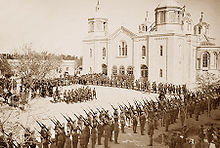 Allenby's march in Russian Compound 1917
Allenby's march in Russian Compound 1917
In 1931 the British authorities requested that the chief rabbi appoint a prison chaplain who would visit the captives on Shabbat. Rabbi Aryeh Levine became famous as the "Rabbi of the Prisoners". Every Sabbath, he would walk from his home to the Russian Compound, to conduct services with the prisoners and keep them company. He was known as the "tzaddik (righteous person) of Jerusalem". In 1965, "Rav Aryeh" was honored at a ceremony assembled by the veteran underground resistance fighters. Timed to take place on his 80th birthday, it was held in the courtyard of the old central prison.
As British control over the political situation in Mandatory Palestine steadily weakened, harsher measures were enacted. The British finally decided to begin executing Jewish underground prisoners in the prison. In 1947, two condemned Jews, Meir Feinstein and Moshe Barazani, blew themselves up in the night before their execution with a hand grenade which had been smuggled into the cell inside of an orange.
Immediately after the last British soldiers had left Jerusalem in 1948, underground fighters of the Irgun took over the vacant Generali building on the corner of Jaffa and Shlomzion Hamalka streets. After raising the national flag above the statue of the winged lion on the roof of the building, they turned towards the Russian Compound, where the British intelligence (CID) was. Several members of the Irgun force had been incarcerated in the central prison and felt particular satisfaction in returning there as victors.
On May 15, 1948, during the War of Independence, the compound was captured by the Haganah with the assistance of the Etzel and Lehi in a campaign known as Operation Kilshon (Operation Pitchfork).
State of Israel
In 1948, after the Soviet Union recognize the state of Israel, Israel returned all Russian church properties on its territory to the Moscow Patriarch, including the Russian Compound. In 1964 the property was purchased by the government of Israel except for the cathedral and one building. The purchase was paid for in $3.5 million worth of oranges[5] since at the time Israel had a shortage of hard currency.[6] The Jerusalem municipality was built here with the adjacent Safra Public Square. Today, the neglected but architecturally striking enclave serves as an Israeli lock-up; at visiting times, families of prisoners can often be seen huddling outside the police barricades. The Ministry of Agriculture, courts, and the Jerusalem’s police headquarters are housed in other buildings.
For many years the Russian Compound was a centre of Jerusalem nightlife, featuring pubs with names like Glasnost, Cannabis and Putin. The municipality has recently closed the "pub district" in the neighbourhood of the restaurants and bars of Ben-Yehuda and Jaffa Road, and is planning on redeveloping it as the new business and culture district. Plans include a circular plaza around the cathedral, a shopping center and renovation and redesignation of the historic buildings in the compound.
The new campus of the Bezalel Art school will be central to this rehabilitation. In 2006, an international architects competition was declared open for design of the future campus which is expected to promote interaction between the students and the surrounding heart of urban life on the line separating east from west in Jerusalem, bringing a student and bohemian population to the city center, and constituting an unusual challenge for designers.
In October 2008 the Israeli government agreed to transfer to Russia Sergei's Courtyard, which had originally also been a part of the Russian compound and which had been housing offices of Israel's Agriculture Ministry and the Society for the Protection of Nature in Israel.[5][6] The government departments housed there were relocated in March 2011. [7]
The buildings in the Compound
Holy Trinity Cathedral The Holy Trinity Cathedral was built as the center of the Russian Compound with funds donated by the people of the Russian Empire. Construction began in 1860, the magnificent edifice was consecrated in 1872. The whole surface of its interior main hall and dome and two aisles is painted an inspiring celestial blue with salmon accents and numerous depictions of saints. The church has four octagonal bell towers. Over the years the bright green domes made this one of Jerusalem’s most distinctive churches.
Russian Mission Building "Duhovnia" The long building lies south of the cathedral towards the new city hall. Built in 1863 as a hospice it also hosted the offices of the ecclesiastical mission of the Russian patriarchate, named "Duhovnia". It’s a courtyard structure with a church in the center. The building has housed all of Jerusalem’s courts, including the Israeli Supreme Court until 1992. The building is now used only for lower law courts and the peace court. The Russian Mission has still an office in the back, but the center is now on the Mount of Olives, directly eastward of the Compound.
Southern Gate Between the mission and the hospital on Safra square. The gate was built in 1890 as part of the perimeter wall of the Russian Compound. It was moved from its original location about 50 meters south of where it now stands as part of the Safra Square Project and the new City hall.
Hospital Safra square 13
Russian Consulate On Shivtei Yisra’el street behind the municipality complex. It was erected in stages since 1860 for the Russian consulate, and combines European characteristics with local building techniques. From 1953-1973 it housed the school of pharmacy, later laboratories of the Hebrew university.
Elisabeth Courtyard - Hostel for Men A courtyard structure built in 1864 as a hostel able to accommodate about 300 pilgrims is located on today's Monbaz street. Above the neo-classical entrance is an inscription marking it as "Elisbeth Courtyard" and the emblem of the Imperial Russian Orthodox Palestine Society. It houses now the police headquarters.
'Northern Gate Right opposite to the Sergei building. Around the Compound was a perimeter wall with two formal gates at north and south, built in 1890. Only one of the two Northern gate houses has survived. The other was pulled down in the 1970s. On the façade is the emblem of the "Imperial Russian Orthodox Palestine Society".
Marianskya Courtyard - Hostel for Women 1 Misheol Hagvurah Street. The hostel for Russian women pilgrims was built 1864 in neo-classical style. At the front of the building one can see the Russian inscription "Marianskya women's hostel" and the symbol of the "Imperial Russian Orthodox Palestine Society" above the entrance. With long hallways leading to separate rooms, it was an ideal layout for a hostel, or a prison, which is exactly what the British turned the place into during the British mandate period. In each cell, one prisoner was made supervisor over the others, and given an actual bed. Over the course of the British occupation, hundreds of prisoners, both simple criminals and political, passed through its gates. Jews and Arabs were incarcerated together. Executions for capital crimes were commonplace, but only for Arabs. While the facility housed many death-row inmates captured from the Jewish underground organizations, Jews sentenced to death were sent to Acco for the actual executions. The British, fearful of the Jewish reaction to executions in the holy city, never used the gallows of the prison for Jews. Prisoners from the Jewish underground organizations were often put to work making coffins and gravestones for the very same British policemen and soldiers they had killed. As the guards used to tell them, "What you start on the outside, you finish on the inside." The building houses now the Underground Prisoner's Museum. The wire fence, bars and inscription "Central Prison Jerusalem" on the door are from the British Mandatory period.
Sergei Building Corner of Heleni HaMalka and Monbaz street. Courtyard structure with a Renaissance style imperial tower, named for Grand Duke Sergei (1857–1905), brother of csar Alexander III, then President of the Provoslavic Palestine Association. Completed in 1890 by architect Frank Gia it was built for pilgrims from the Russian nobility as "Sergej Imperial Hospice". It occupied 9 acres (36,000 m2) of land, and was made entirely out of hewn stone, its 25 luxuriously furnished rooms intended as lodgings for aristocrats. It was referred to as "one of the most marvellous buildings in the city" by the newspapers. Since the British mandate period it has been used for offices, first by the British administration as the public works department and passport offices, where the British denied Jews the certificates they desperately needed for immigration to Palestine. The Sergei building is one of the houses in Jerusalem most famous for its beauty, and captured Vladimir Putin’s heart during his last visit to Israel.
Nikolai Courtyard - Pilgrims Hostel In 1903 another hostel for Russian pilgrims, the Nikolai Pilgrims Hostel, was built which was large enough to hold 1,200 guests. Since the British mandate period part of it has been used as police headquarters and as government offices. Later it was the British intelligence headquarters, blown up twice by the Jewish underground under Menachem Begin in 1945.
Archaeology
Main article: Finger of OgIn front of the police headquarters on Shne’eor Chesnin street in a hollow in the ground. Colossal monolithic column dating from late second temple period, discovered in 1871. In ancient times there was a quarry here, and a relic of it is still to be seen in the form of that column fully 12 m (40 ft) long which broke while it was being quarried and was left in situ, still embedded in the natural rock. The column was presumably destined either for the colonnades of the Herodian Temple or - as a number of capitals found here suggest - for a building of the Theodosian period (second half of 4th century).
References
- ^ Jerusalem: Architecture in the late Ottoman Period
- ^ The writing on the wall | Jerusalem Post
- ^ Around the corner for a drink | Jerusalem Post
- ^ Portrait of a Duke, Tom Segev, Haaretz
- ^ a b Sergei's Courtyard. Jerusalem Post, October 5, 2008. Accessed October 7, 2008.
- ^ a b Russia's Jerusalem land claim worries Israelis. Associated Press, YahooNews, October 7, 2008. Accessed October 7, 2008.
- ^ http://www.haaretz.com/print-edition/news/israel-vacates-sergei-courtyard-ahead-of-netanyahu-s-moscow-visit-this-week-1.351002
Bibliography
- Ely Schiller (ed.): The Heritage of the Holy Land. A rare collection of photographs from the Russian Compound 1905-1910, Arie Publishing House, Jerusalem, 1982
- David Kroyanker (ed.): The Russian Compound: Toward the Year 2000. From Russian Pilgrimage Center to a Focus of Urban Activity The Jerulme Municipality, 1997
- David Kroyanker: Jerusalem Architecture (p. 132-135, The Russians). (Introduction by Teddy Kollek), Keter Publishing House Ltd., 1994, 2002
- Yehoshua Ben-Arieh: Jerusalem in the 19th century. Emergence of the New City, St Martin's Press New York/Yad Izhak Ben-Zvi Jerusalem, 1986
- S. Graham: With the Russian Pilgrims to Jerualem, London 1914
- Aviva Bar-Am: Return to Bevingrad, Jerusalem Post (Magazine), September 19, 2003
See also
Neighborhoods of Jerusalem Old City East Jerusalem American Colony • Al Bustan • Al-Issawiya • At-Tur • Bab a-Zahara • Beit Hanina • Jabel Mukaber • Ma'ale ha-Zeitim • Nachalat Shimon • Nof Zion • Ras al-Amud • Sheikh Jarrah • Shimon HaTzadik • Shuafat • Silwan • Sur Baher • Umm Tuba • Wadi al-JozHaredi neighborhoods Batei Munkatch • Batei Ungarin • Beit Yisrael • Ezrat Torah • Geula • Givat Shaul • Har Nof • Kerem Avraham • Kiryat Belz • Kiryat Mattersdorf • Kiryat Sanz • Kiryat Shomrei Emunim • Machanayim • Mea Shearim • Mekor Baruch • Nachalat Ya'akov • Ramat Shlomo • Ramot Polin • Sanhedria • Sanhedria Murhevet • Sha'arei Hesed • Shmuel HaNavi • Tel Arza • Unsdorf • Zikhron MosheCentral Neighborhoods Batei Nissan Bak • Beit David • Beit Ya'akov • Bukharan neighborhood • Even Yisrael • Ezrat Yisrael • Givat Ram • Katamon • Kiryat Shmuel • Kiryat Wolfson • Mahane Israel • Mahane Yehuda • Merhavia • Mishkenot Sha'ananim • Musrara • Nachalat Achim • Nachlaot • Nayot • Neve Sha'anan • Ohel Shlomo • Rehavia • Yemin MosheNorthern Neighborhoods French Hill • Givat HaMivtar • Ma'alot Dafna • Neve Yaakov • Pisgat Ze'ev • Ramat Eshkol • Ramot • Ramot PolinSouthern Neighborhoods Abu Tor • Baka • Beit Safafa • East Talpiot • The German Colony • Gilo • Givat HaMatos • Greek colony • Har Homa • Mekor Chaim • Ramat Rachel • TalpiotWestern Neighborhoods Bayit VeGan • Beit HaKerem • Givat Massuah • Givat Mordechai • Givat Oranim • Har Hotzvim • Ir Ganim • Katamonim • Kiryat HaYovel • Kiryat Menachem • Kiryat Moshe • Malha • Motza • Pat • Ramat Beit HaKerem • Ramat Denya • Ramat Sharett • Romema • Yefeh NofHistoric Neighborhoods See also: Ring NeighborhoodsCoordinates: 31°46′55.47″N 35°13′18.17″E / 31.782075°N 35.2217139°E
Categories:- Neighbourhoods of Jerusalem
- Populated places established in 1860
- Churches in Jerusalem
- History of Russia
- Israel–Soviet Union relations
- Museums in Jerusalem
- British Mandate for Palestine
- Arab–Israeli conflict
- British Empire
- History of Israel
- Irgun
- Israel Defense Forces
- National liberation movements
Wikimedia Foundation. 2010.

